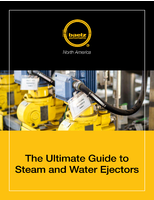ASHRAE Book focuses on energy-efficient datacom facilities.
Press Release Summary:
Best Practices for Datacom Facility Energy Efficiency provides guidance to assist those involved in the design, construction, commissioning, operation, implementation, and maintenance of datacom equipment centers. The book provides a listing of best practices in areas such as environmental criteria, mechanical equipment and systems, economizer cycles, airflow distribution, HVAC controls and energy management, electrical distribution equipment, datacom equipment efficiency, and liquid cooling.
Original Press Release:
Design of Energy Efficient Datacom Facilities Focus of ASHRAE Book
ATLANTA - Datacom center energy use is typically large and concentrated (it can be 100 times the watts per square foot of an office building), with operations running 24 hours, 7 days a week, about three times the annual operating hours of most commercial properties.
As a result, issues such as sustainable design, energy efficiency and operating cost become critically important for these facilities.
Guidance to assist those involved in the design, construction, commissioning, operation, implementation and maintenance of datacom equipment centers is available in a new book from ASHRAE, Best Practices for Datacom Facility Energy Efficiency.
"This book provides detailed information on the design of datacom facilities that will aid in minimizing life-cycle cost and maximizing energy efficiency," said Tom Davidson. "The overall goal is to minimize total cost of ownership (TCO) for the end user, while helping to conserve energy resources on a global scale."
Davidson is a member of ASHRAE's technical committee on mission control facilities, technology spaces and electronic equipment, which wrote the book.
A study conducted by Lawrence Berkeley National Laboratory on average data center power allocation showed that only 46 percent of power was used by information technology (IT) equipment such as servers, while 23 percent was used by HVAC cooling equipment, 8 percent by HVAC fans, 8 percent by uninterruptible power supply equipment losses, and 4 percent by lighting. Another 11 percent was attributed to other uses, such as miscellaneous electrical losses, support office area, etc.
"Since the infrastructure/energy cost is an increasing component of total cost of ownership, a strong emphasis must be placed on this cost to keep a datacom facility energy efficient and operating at the lowest cost to support the level of reliability and availability of the equipment it houses," he said.
The book provides a listing of best practices in the areas of environmental criteria, mechanical equipment and systems, economizer cycles, airflow distribution, HVAC controls and energy management, electrical distribution equipment, datacom equipment efficiency, liquid cooling, total cost of ownership and emerging technologies.
Examples of the best practices include:
Environmental Criteria
Adoption of temperature and humidity ranges provided in ASHRAE's Thermal Guidelines for Data Processing Environments publication can result in increased energy efficiency.
Mechanical Equipment and Systems
For computer room air-conditioning equipment, focus the cooling solution on very high sensible/total cooling capacities per the revised ANSI/ASHRAE Standard 127-2007.
Economizer Cycles
Raising the supply air setpoint in a facility can significantly increase the number of cooling hours in economizer mode.
Airflow Distribution
Recognize that datacom equipment loads will change over the next 10 to 15 years. Develop a cooling distribution strategy that can adjust to these changes.
HVAC Controls and Energy Management
Investigate the costs and benefits of different methods for humidity control. System design and control algorithms should allow the primary cooling coils to 'run dry' and thus allow for chilled-water reset at light loads without impacting relative humidity.
Electrical Distribution Systems
Consider distributing high-voltage AC or DC power to point of use.
Datacom Equipment Efficiency
Select power equipment from the highest input voltage available within its input voltage rating range.
Liquid Cooling
Consider the use of a cooling distribution unit (CDU) to isolate the liquid cooling loop from the building chilled-water cooling loop. This allows the liquid cooling loop temperature to be set above the room dew-point temperature, thus eliminating condensation.
Total Cost of Ownership (TCO)
Use energy system modeling software to aid in developing an accurate TCO.
Commissioning
Verify and document that the facility, its systems and assemblies are designed, installed and maintained in accordance with the owner's program requirements.
The book is part of the ASHRAE Datacom Series, developed to provide a more comprehensive treatment of datacom cooling and related subjects. Other books in the series are ASHRAE's Design Considerations for Datacom Equipment Centers, Thermal Guidelines for Data Processing Environments, Liquid Cooling Guidelines for Datacom Equipment Centers, Datacom Equipment Power Trends and Cooling Applications and Structural and Vibration Guidelines for Datacom Equipment Centers.
The cost of Best Practices for Datacom Facility Energy Efficiency is $59 (ASHRAE members, $47). To order, contact ASHRAE Customer Service at 1-800-527-4723 (United States and Canada) or 404-636-8400 (worldwide), fax 404-321-5478, or visit at www.ashrae.org/bookstore.
ASHRAE, founded in 1894, is an international organization of some 50,000 persons. ASHRAE fulfills its mission of advancing heating, ventilation, air conditioning and refrigeration to serve humanity and promote a sustainable world through research, standards writing, publishing and continuing education.




